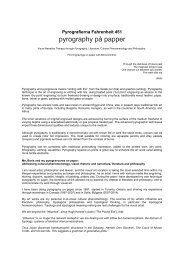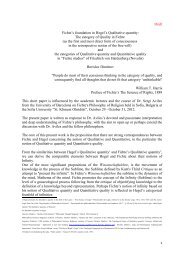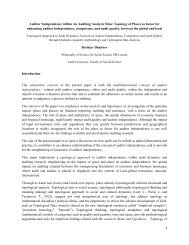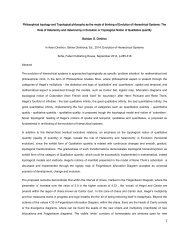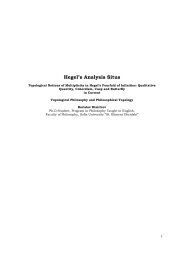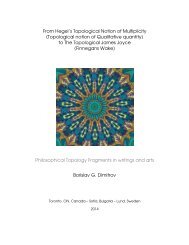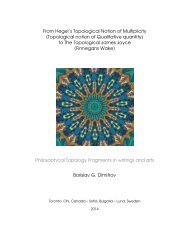Topological Ontology and Logic of Qualitative quantity
Qualitative quantity and BFO (Basic Formal Ontology) of /Barry Smith/ and YAMATO (Yet Another More Advanced Top-level Ontology) of /Riichiro Mizoguchi/
Qualitative quantity and BFO (Basic Formal Ontology) of /Barry Smith/ and YAMATO (Yet Another More Advanced Top-level Ontology) of /Riichiro Mizoguchi/
- No tags were found...
Create successful ePaper yourself
Turn your PDF publications into a flip-book with our unique Google optimized e-Paper software.
3.Quality: It is a property associated with an individual entity <strong>and</strong> is a generic name to<br />
denote each instance <strong>of</strong> quality role type: e.g., John’s height, Tom’s weight, area <strong>of</strong> the<br />
cross section <strong>of</strong> this pipe, length <strong>of</strong> this pen, etc.<br />
4.Quality instance: A realization <strong>of</strong> quality: e.g., John’s height <strong>of</strong> 160cm long, Tom’s<br />
weight <strong>of</strong> 50kg, etc.”<br />
According to Richiro Mizoguchi, the existing similar terms such as property, attribute,<br />
quality, quality type, quality role type <strong>and</strong> <strong>quantity</strong> are dependent entities <strong>and</strong> cannot exist<br />
without an entity with which they are associated. It is almost impossible to define these<br />
terms without discussing deep issues related to them. Because <strong>of</strong> this difficulty, terms such<br />
as attribute<strong>and</strong> property used thus far should not be taken as technical terms but as<br />
common words which are vaguely defined.”<br />
Mizoguchi establishes that:<br />
“… now it is the time to differentiate them based on our discussion thus far. Quality,<br />
quality role type <strong>and</strong> <strong>quantity</strong> are already defined with examples. So, the problem is the rest<br />
two. Therefore, these terms appearing below should be taken as defined here.<br />
Property: As a common term, property is almost a synonym <strong>of</strong> quality in our context. As a<br />
technical term, however, they are different. The major difference is that while a property<br />
can be used as any predicate to any individual like human(x) or animal(x), quality is used<br />
only for what an entity has. However, considering that our problem in this paper is to talk<br />
about how to describe/characterize entities, property <strong>and</strong> quality become synonym again<br />
because there is no necessity for talking about “human as a property” when describing<br />
“human” entity. This definition is only valid in the following sections in this paper, that is,<br />
the term property appearing in the above should not be taken as defined here. Because we<br />
defined quality differently from what is defined in BFO, by property, I mean “quality”<br />
used in BFO, that is, value combined with its variable or the variable taking a value that can<br />
be possessed by an entity. I think I need to defend my decision on this. Quality must be<br />
something associated with an entity <strong>and</strong> can change with keeping its identity. These<br />
characteristics necessarily derive that quality cannot be something combined with its<br />
value, otherwise, it cannot keep its identity when its value has changed. Therefore, the<br />
notion <strong>of</strong> quality employed in BFO is not appropriate in this respect. As was already<br />
discussed, an instance <strong>of</strong> BFO-defined quality such as “John’s height <strong>of</strong> 160cm long” is<br />
called quality instance <strong>and</strong> any length whose value is 160cm is represented as property in<br />
YAMATO, though property is defined mainly for qualitative property such as being red,<br />
being natural, being artificial, etc..<br />
Attribute: Originally, it is a binary predicate which relates an entity to its quality instance,<br />
e.g., length(pen_1, 10cm). In AI, is <strong>of</strong>ten used to describe entities. In such cases,<br />
“A” st<strong>and</strong>s for quality role type <strong>and</strong>/or generic quality type. Following the use <strong>of</strong> this term<br />
in AI, we could define attribute as a synonym <strong>of</strong> generic quality type. However, we<br />
intentionally leave this term undefined for flexible use in text. So, the term attribute should<br />
be taken as a common term in this paper. In YAMATO implemented in Hozo, the term<br />
property<br />
is used to mean BFO’s quality. Because the role hierarchy is implicit in Hozo, hierarchies <strong>of</strong><br />
quality <strong>and</strong> quality role type are invisible unless Role hierarchy mode <strong>of</strong> Hozo is used.”<br />
The problem is two fold: (a) one way <strong>of</strong> representation is not enough for real world<br />
problems because there exist multiple kinds <strong>of</strong> quality descriptions in the real data <strong>and</strong> (b)<br />
there is no explicit model <strong>of</strong> how these three are different from <strong>and</strong> interrelated with each<br />
other.<br />
21





